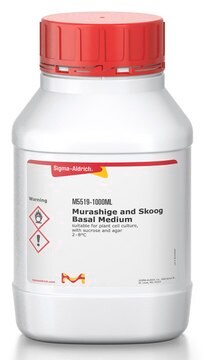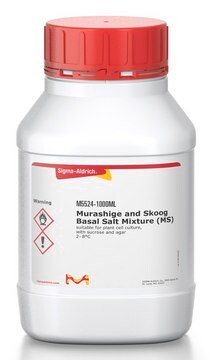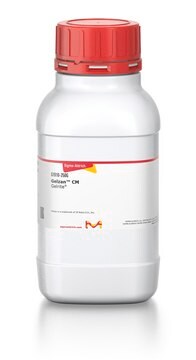A7921
Agar
suitable for plant cell culture, powder
Synonym(s):
Agar-agar, Gum agar
Sign Into View Organizational & Contract Pricing
All Photos(4)
About This Item
Linear Formula:
(C12H18O9)n
CAS Number:
EC Number:
MDL number:
UNSPSC Code:
50405901
eCl@ss:
42040102
NACRES:
NA.21
Recommended Products
biological source
algae (Rhodophyceae)
Quality Level
form
powder
technique(s)
cell culture | plant: suitable
transition temp
congealing temperature 30-35 °C
application(s)
agriculture
storage temp.
room temp
InChI
1S/C14H24O9/c1-5-8(16)13-11(7(21-5)4-20-13)23-14-10(18)12(19-2)9(17)6(3-15)22-14/h5-18H,3-4H2,1-2H3/t5?,6-,7?,8-,9+,10-,11?,12+,13+,14?/m1/s1
InChI key
GYYDPBCUIJTIBM-DYOGSRDZSA-N
Looking for similar products? Visit Product Comparison Guide
General description
Agar contains agarose and agaropectin, with agarose being the major gelling heteropolysaccharide. Agarose contains β-d-galactose and 3,6-anhydro-α-l-galactose, linked by glycosidic bonds β(1-4) called the neoagarobiose. It also has agarobiose with same disaccharide units with α(1-3) linkage. The major source of agar is the cell wall of seaweed from Rhodophyceae family.
Application
Agar has been used as a component of EDMm (modified version of Eucalyptus dunnii basal medium (EDM)) for development of shoots of Eucalyptus dunnii clones. It has also been used as a component of Murashige and Skoog medium for in vitro culture of Strain TC09 of Cladosporium sphaerospermum.
Agar has been used as a component
- of Gamborg′s B5 regeneration medium
- of Murashige and skoog (MS) medium for the germination of Hypericum triquetrifolium Turra seeds
- in shoot inducing and naphthalene acetic acid pretreatment medium for the regeneration of Arabidopsis thaliana seedlings
Biochem/physiol Actions
Agar is majorly used as microbial solid culture media. It is used in the range of 0.5 to 1.0% (w/v) to solidify plant tissue culture media. It is essential for in vitro root development.
Other Notes
Purified for research and protoplast culture.
Preparation Note
Typical working concentration: 6-12 g/L.
Storage Class Code
11 - Combustible Solids
WGK
WGK 1
Personal Protective Equipment
dust mask type N95 (US), Eyeshields, Gloves
Choose from one of the most recent versions:
Already Own This Product?
Find documentation for the products that you have recently purchased in the Document Library.
Customers Also Viewed
Plant Tissue Culture, Development, and Biotechnology, 21(11), 1577-1577 (2011)
AGAR DOES NOT AFFECT IN VITRO RHIZOGENESIS AND EX VITRO ACCLIMATIZATION OF Handroanthus chrysotrichus
Rabaiolli SMS, et al.
CERNE, 23(2), 185-192 (2017)
Thidiazuron induced micropropagation of Hypericum triquetrifolium Turra
Oluk, E and Orhan, Serpil
African Journal of Biotechnology, 8(15), 771-777 (2009)
A new transformation-regeneration procedure in the model legume Lotus japonicus: root explants as a source of large numbers of cells susceptible to Agrobacterium-mediated transformation
Lombari P, et al.
Plant Cell Reports, 21(8), 771-777 (2003)
Bety Shiue de Hsie et al.
Journal of photochemistry and photobiology. B, Biology, 198, 111577-111577 (2019-08-04)
Lippia rotundifolia Cham. is in the family Verbenaceae and is endemic to the Cerrado. This species is aromatic and characterized by the presence of glandular trichomes on its leaves that are rich in monoterpenes. The objective of this study was
Our team of scientists has experience in all areas of research including Life Science, Material Science, Chemical Synthesis, Chromatography, Analytical and many others.
Contact Technical Service



